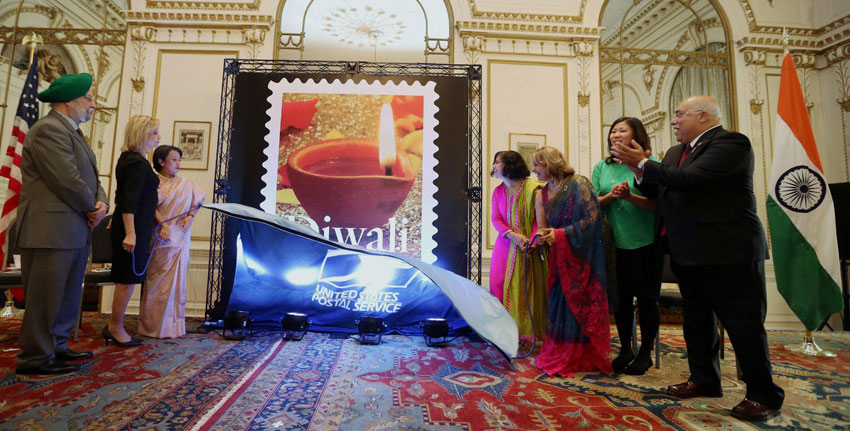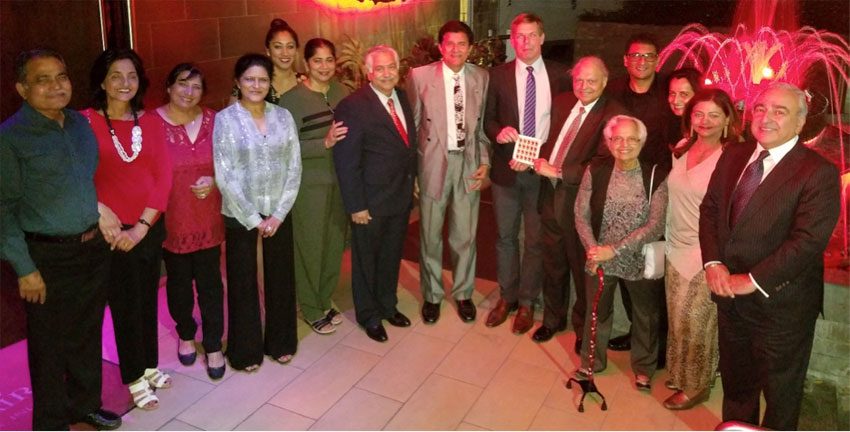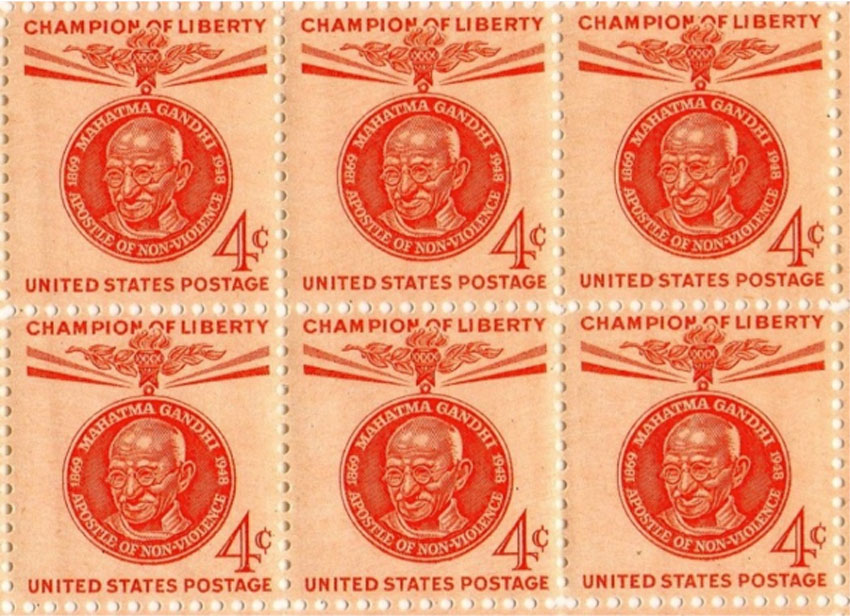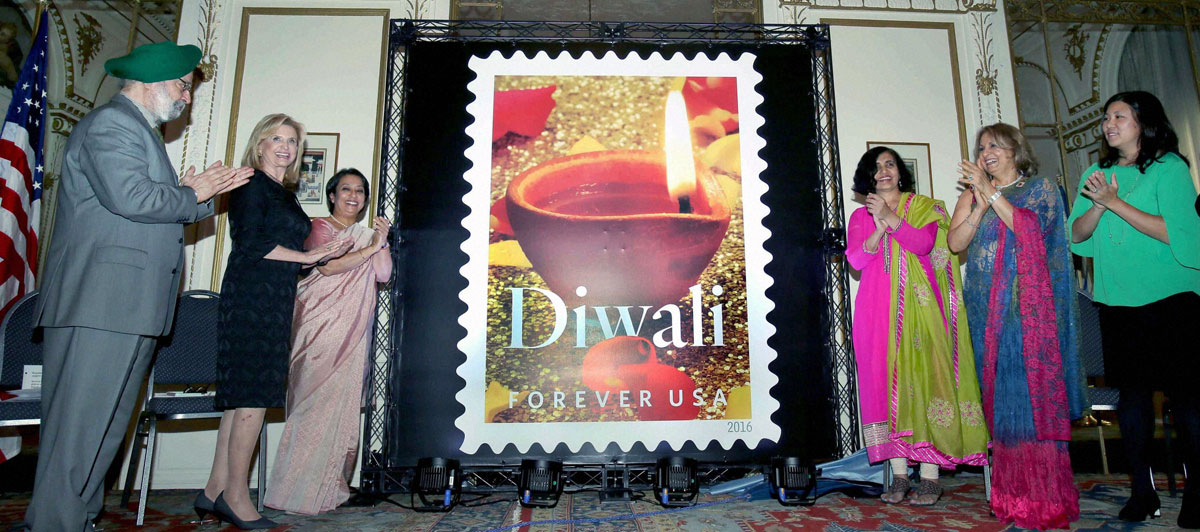DIWALI STAMP FINALLY RELEASED BY USPS
(L-r): Ambassador Hardeep Singh Puri, Congresswomen Carolyn B. Maloney, NY Consulate General Riva Ganguly Das, Pritha Mehra, VP Mail Entry USPS, Ranju Batra Chair Stamp Committee, and Congresswomen Meng at the release ceremony of Diwali Stamp at Indian Consulate, Oct. 5, in New York. (Press Trust of India)
October 5, 2016 will go down in the history of Indian American community as the day when the United States Postal Service (USPS) released Diwali stamp, writes Inder Singh. – @siliconeer #siliconeer #community #USPS #DiwaliStamp #USPSDiwaliStamp #IndianAmerican
At long last, the Citizen’s Stamp Advisory Committee fulfilled the long-standing demand of Indian Americans and announced on August 23, 2016 the issuance of postage stamp commemorating the festival of Diwali. The dedication ceremony took place at the Consulate General of India, New York, Oct. 5, the first day of issue of the Forever postage stamp in the presence of Consul General Ambassador Riva Ganguly Das, Representative Carolyn Maloney, Diwali Stamp Project Chair Ranju Batra, USPS Vice President for Mail Entry and Payment Technology Pritha Mehra, India’s former Permanent Representative to the United Nations Ambassador Hardeep Singh Puri and many members of the local Indian American community.
It was in 2004, when Dr. Shailendra Kumar, Chairman, Diwali Postage Stamp Committee of Association of Indians in America and its president Dr. Piyush Agrawal jointly wrote to the Citizen’s Stamp Advisory Committee requesting the issuance of a postage stamp for Hindu Festival of Diwali. Since then, several Indian national and local organizations in America have been pursuing relentlessly with the Stamp Advisory Committee for a Diwali stamp. They reminded the committee that they have already issued Christmas, Kwanzaa, Hanukkah and Eid stamps. They urged them to respect diversity and equality, and issue a Diwali stamp also. Diwali Stamp Project Chair Ranju Batra of New York and several Indian organizations all over the United States collected thousands of petitions from the members of the community and many thousands signed the electronic version of the petition. Some U.S. Congressmen wholeheartedly supported the demand of the Indian Americans and sent letters to the Citizen’s Stamp Advisory Committee.

In 2015, U.S. Senate Resolution 113 was introduced “Expressing the sense of the Senate that the Citizens’ Stamp Advisory Committee should recommend the issuance of, and the United States Postal Service should issue, a commemorative stamp in honor of the holiday of Diwali.” It was thus a moment of pride that the relentless pursuit for the issuance of a Diwali stamp culminated in USPS announcement to release the stamp on October 5, 2016 to commemorate the Hindu festival of Diwali, also known as the Festival of Lights.
The Citizens’ Stamp Advisory Committee (CSAC) is appointed by the Postmaster General to evaluate all stamp proposals and recommend stamp subjects to the Postmaster General, who makes the final decision. One of the important functions of the CSAC is to ensure that every proposal is given the same level of consideration, “regardless of any professional lobbying efforts, letter-writing campaigns, petitions, and/or appeals to influential politicians.” In spite of the stated role of the CSAC, Indian American community activists continued to educate those who have the power to change old rules to accommodate new realities to achieve their goal.
Diwali is celebrated by over one billion people in the world including over 2 million Indian Americans. Hindus celebrate Diwali as it commemorates the return of Lord Rama with his wife Sita and brother Lakshman, from their 14-year exile after killing the demon king Ravana. Thus, it symbolizes the victory of good over evil and is celebrated with great fervor by one and all. The Sikhs celebrate Diwali as it marks the release of the sixth Guru, Hargobind Rai in October 1619, from the fort of Gwalior where he was imprisoned by Mughal emperor Jahangir, along with 52 Hindu kings. The Guru also managed to get all the Hindu kings freed at the same time. In Jainism, the occasion celebrates the attainment of Nirvana by Lord Mahavir.
In 2003, the President of the United States agreed to the long-standing demand of the Indian community and celebrated Diwali at the White House in the presence of several invited Indian community leaders. Since then, Diwali festivities at the White House have become an annual tradition which also shows the growing clout of the Indian American community in the United States. The U.S. Senate and the House of Representatives in October 2007 unanimously passed Resolutions 299 and 747 respectively, recognizing the “religious and historical significance of the festival of Diwali.” The passage of the resolutions may be symbolic, but it is a testament to the increased awareness of the Indian community in America. In 2009, President Barack Obama became the first U.S. President to light a “diya” oil lamp in a White House ceremony for the festival of lights.

In communicating his warm greetings at the occasion, he remarked that Diwali marked the return of the Lord Ram from exile when small lamps lit his way home. In 2010, the Vice President led the commemoration. In 2011, President Obama again lit the White House Diya while a Hindu priest chanted Shlokas, or prayers.
The U.S. Congress celebrated Diwali, for the first time, on October 29, 2013, amidst chanting of Vedic mantras by a Hindu priest. Over two dozen influential lawmakers along with eminent Indian Americans gathered at the Capitol Hill to light the traditional “diyas.” The event was organized by the two co-chairs of the Congressional Caucus on India and Indian Americans, Congressmen Joe Crowley and Peter Roskam in recognition of increasing presence of the Indian American community.
In 2015, Congressmen Ami Bera and George Holding, Democratic and Republican co-chairs of the Caucus on India and Indian Americans organized the Diwali celebrations. More than 30 members of U.S. Congress and about 1,000 people from the community participated at the annual Diwali event on Capitol Hill.
In 2002, the Stamp Advisory Committee was requested to issue a commemorative stamp in honor of the first U.S. Congressman of Asian origin, the India born Dalip Singh Saund to coincide with the fiftieth anniversary of Saund’s election to the Congress on November 6, 2006. A few thousand petitions were sent to the Committee. Some Congressmen also sent letters to the CSAC. It was a date bound request and when the CSAC did not respond by November 6, 2006, the request was not pursued any further.

In 1961, the Indian community was very small, less than 50,000 in USA. No Indian American made any request for the issuance of any stamp with Indian personality or object. But the U.S. Postal Service issued two stamps on January 26, 1961, 4¢ first class postage stamp and 8¢ postage stamp to honor Mahatma Gandhi in the “Champion of Liberty” series. The stamp had picture of Gandhi and carried the wording, “Mahatma Gandhi, Apostle of Non-Violence.” Four cent stamps were printed 113 million while the 8 cent stamps were printed 41,644,200.


